Last Updated on April 21, 2023
The Belgian Malinois (Mal dog) is a beautiful breed with a very noble appearance. If you don’t know the breed, you might compare them to a German Shepherd as they have a similar striking yet elegant look.
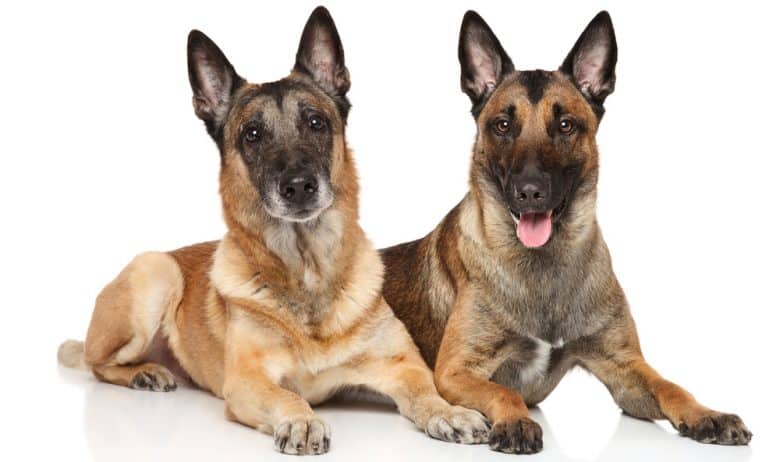
Like GSD, the Belgian Malinois is also often used as a working dog in detective work, police duties, and search and rescue. You may even find these dogs in the White House as protectors.
Despite being excellent on the job, the Belgian Malinois also makes an excellent companion and is known to be strong and intelligent.
So it is no surprise that you’re looking at getting a Belgian Malinois to call your own. But you might still be wondering what color dog will suit you best. Well, you’ve come to the right place.
In this article, we’ll examine the different colors of the Belgian Malinois and look a little closer at their various markings and distinctive features.
Quick Navigation
- 1 How Do Belgian Malinois Color Genetics Work?
- 2 What are the Standard Colors of a Purebred Belgian Malinois?
- 3 Belgian Malinois Coat Markings and Patterns (AKC Standard)
- 4 What are the Other Colors of Belgian Malinoises?
- 5 Mal Dog Colors That Aren’t Allowed
- 6 What is the Most Common Belgian Malinois Color?
- 7 What is the Rarest Belgian Malinois Color?
- 8 Frequently Asked Questions (FAQs)
- 9 Taking Care of Your Mal Dog’s Coat
- 10 Which Belgian Malinois Color Will You Choose?
- 11 Further Reading:
How Do Belgian Malinois Color Genetics Work?
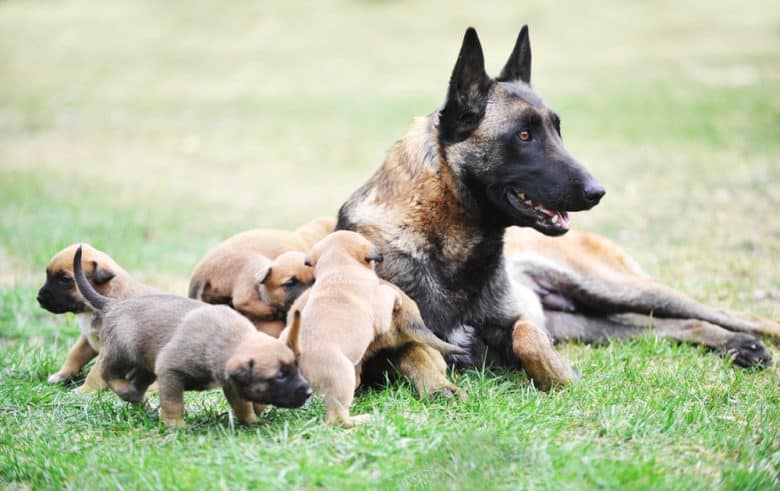
With all dog breeds, including the Belgian Malinois, two different pigments are responsible for creating the color you see on your pet’s coat.
These two pigments are eumelanin which is responsible for dark colors like brown and black, and pheomelanin, which controls the amount of red and yellow in your pet’s coat.
Your pet’s genes then affect the intensity of these pigments, diluting or enhancing the shades to appear different than their base, thus creating the wide range of doggie colors that we see today.
Each puppy inherits two color genes, one from each parent, so even in the same litter, you can get dogs of different colors.
The dominant genes are the ones that are most likely to show, whereas your pup will need two recessive genes for that color to present.
Do their coats change colors as they age?
While some dog breeds coat color is known to change as your dog ages, this generally isn’t the case for the Belgian Malinois. Puppies of this breed will likely keep their color from birth to old age.
While changing from fawn to red or mahogany to sable definitely won’t occur, what might happen is that the exact shade of your dog changes a little bit as he transitions from puppyhood to being an adult dog.
What are the Standard Colors of a Purebred Belgian Malinois?
The various kennel clubs have their own standards for dog breeds. This includes reference to what colors a pet should be.
While the Fédération Cynologique Internationale (FCI) only accepts the Belgian Malinois with a fawn and black overly, according to the American Kennel Club (AKC), the standard colors for the Belgian Malinois are fawn, fawn sable, red, red sable, and mahogany.
1. Fawn
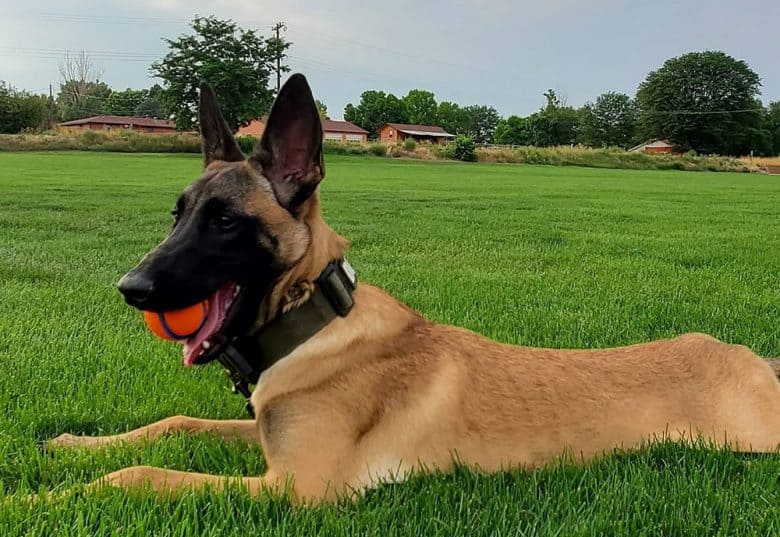
The AKC and the Canadian Kennel Club (CKC) accept fawn as one of the standard colors for this breed and is indeed one of the most common colors.
Fawn Mal dogs are a yellow-tan color with the exact shade varying between very light or quite dark.
Most Fawn Belgian Malinois will have a black mask that covers their muzzle, nose, eyes, and sometimes their ears. Additionally, these dogs will have black noses and dark eyes.
2. Mahogany
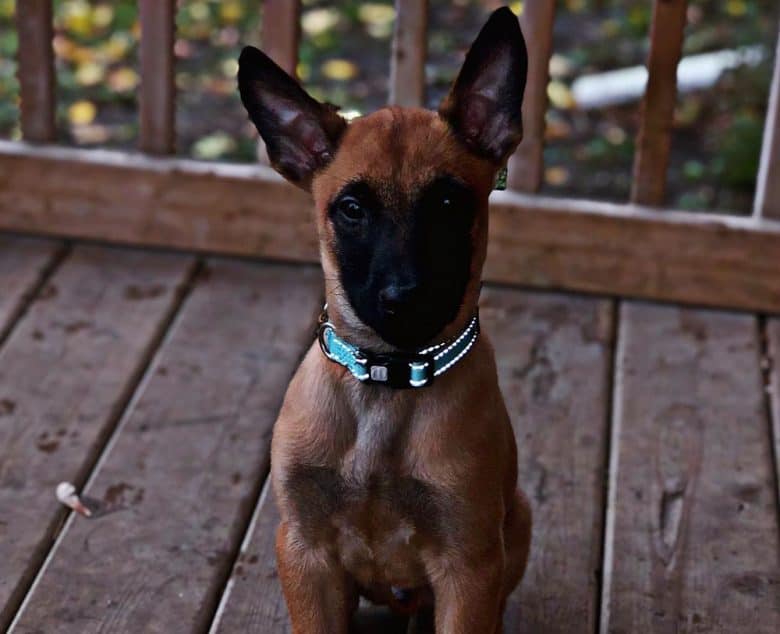
Again, the CKC and the AKC list mahogany as a standard color for the Belgian Malinois. Mahogany Mal dogs are typically a dark reddish-brown, almost black color.
They, too, have dark eyes and a black nose, and while they may have a mask, it will be challenging to differentiate it due to the darker coat color all round.
3. Red
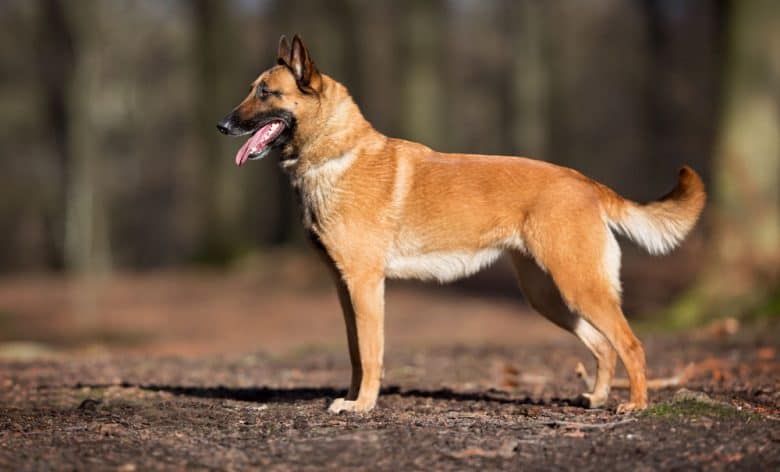
The Red Belgian Malinois has enhanced levels of the pheomelanin gene, giving his coat that beautiful red coloring. This color can vary from light ginger to a deep, dark red.
The Red Mal dogs also have a black mask which will be more prominent on a lighter red coat. These dogs are not quite as common as their fawn counterparts but are not too difficult to acquire.
4. Red Sable
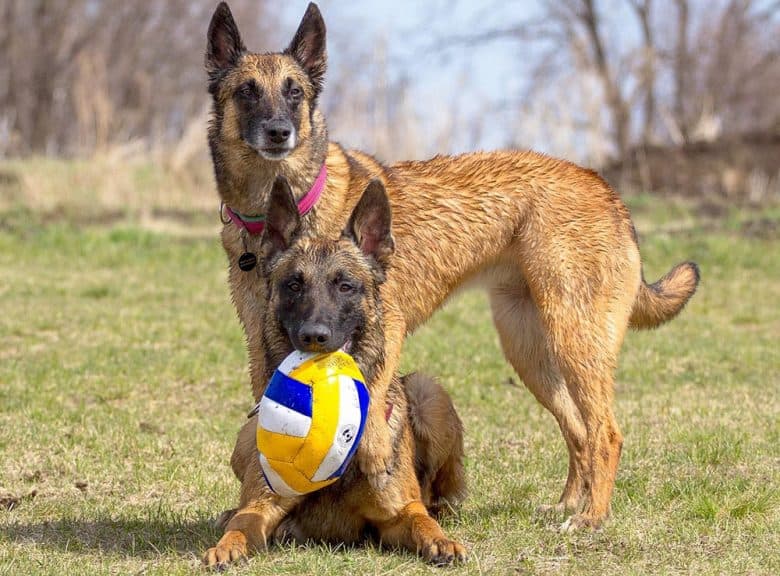
Red Sable Mal dogs have a red coat as a base color, but each hair is also tipped with black. These dogs appear pretty dark, leading some pet owners to think that their Belgian Malinois is just black rather than a red sable.
Like the other coat colors, the Red Sable Belgian Malinois will have very dark brown eyes and a black nose. He likely also has a black mask, but it might not even be noticeable against his almost black coat.
5. Fawn Sable
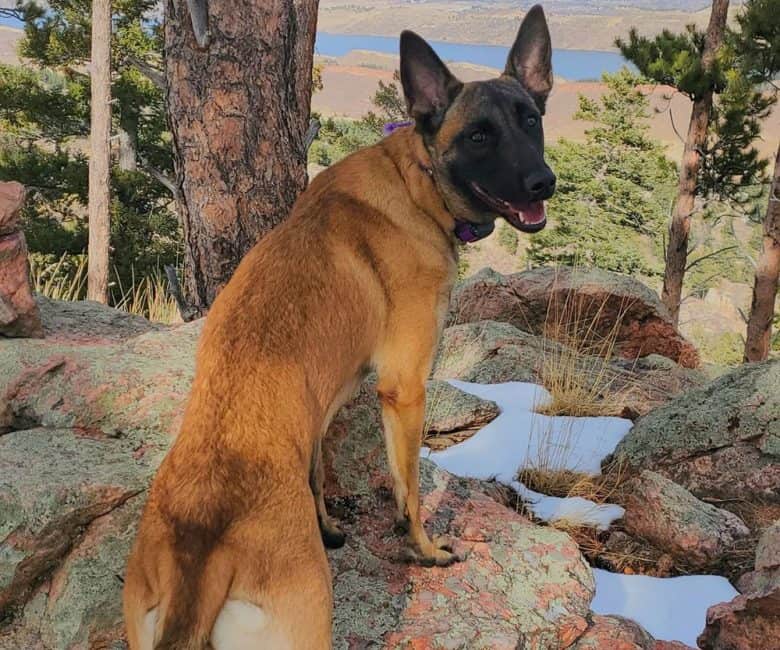
Fawn Sable Belgian Malinois appears to be a regular fawn color but with a sable pattern. The sable patterns mean that the base of the dog’s hair is the fawn color, but the tips are black.
This means that these dogs are darker than regular fawn Belgian Malinois.
These dogs also have dark brown eyes and a black nose, and while they also have a black mask, it likely won’t be as noticeable as on the fawn Belgian Malinois due to the rest of their fur already having some black in it.
What are the Non-Standard Colors of Malinois dogs?
While other colors are typically accepted as purebred Mal dogs, and these dogs can be registered with the kennel club, these canines will not be allowed to be entered into any dog shows.
6. Black
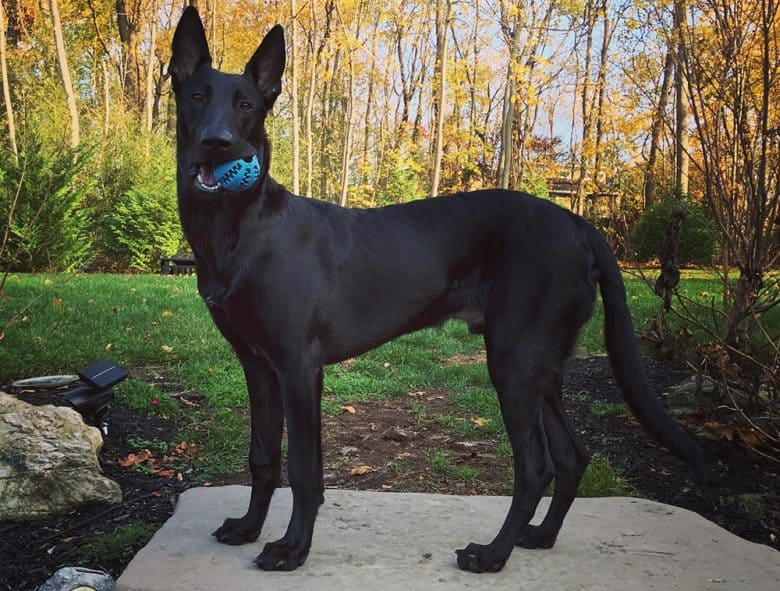
Pure Black Belgian Malinois are pretty rare. Most Belgian Malinois have some other color in them, be it brown, red, or fawn.
Mal dogs with pure black fur have very high concentrations of the eumelanin pigment, and their eye rims, paw pads, noses, and lips will also be dark.
7. Brindle
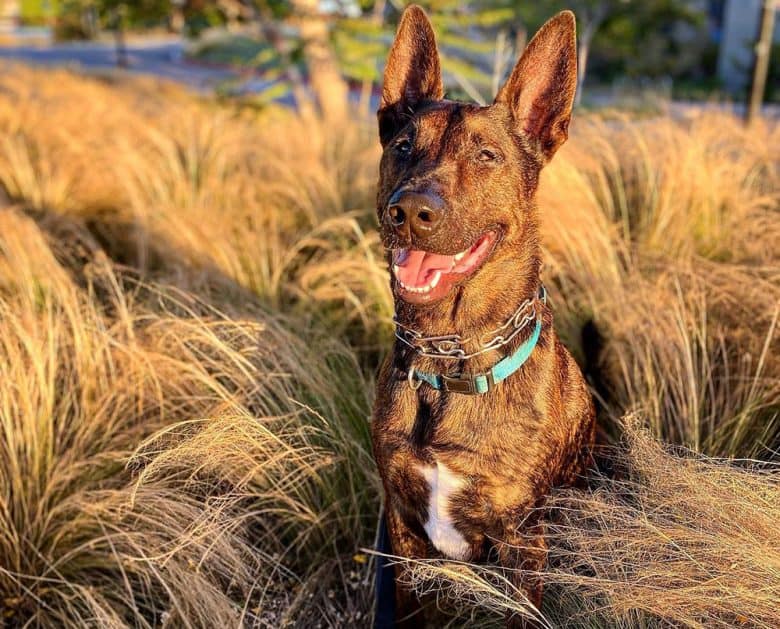
The brindle coat color is a unique variant that will make your Belgian Malinois look like he is wearing tiger stripes. While brindle stripes can appear on any coat color, they are most noticeable on the Fawn and Red Belgian Malinois.
The brindle patterns can cover your dog’s entire coat or just a tiny portion. Some brindle Malinois will also not have a black mask.
8. Cream
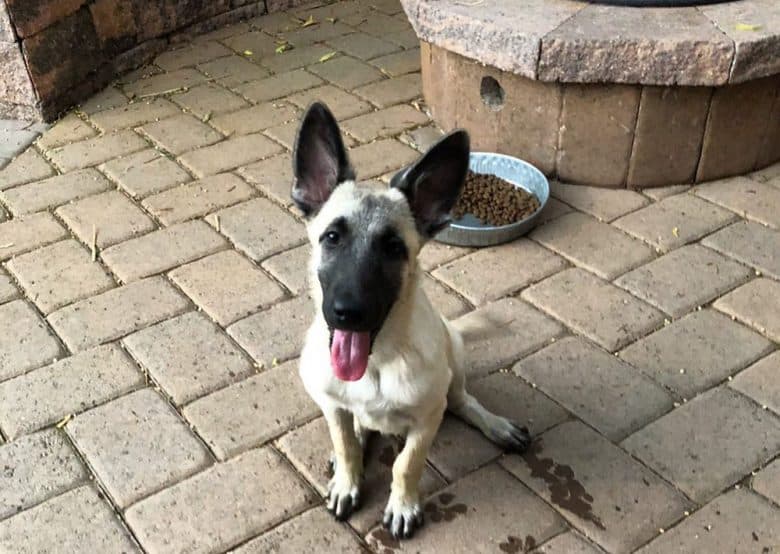
Cream Belgian Malinois have little to no eumelanin pigment, allowing the pheomelanin pigment to take over, giving their coat a light yellow or beige color.
These dogs typically still have a black mask which stands in stark contrast to the cream coat, and they also still usually have the dark eyes, ears, and nose characteristic of the breed.
9. Blue or Gray
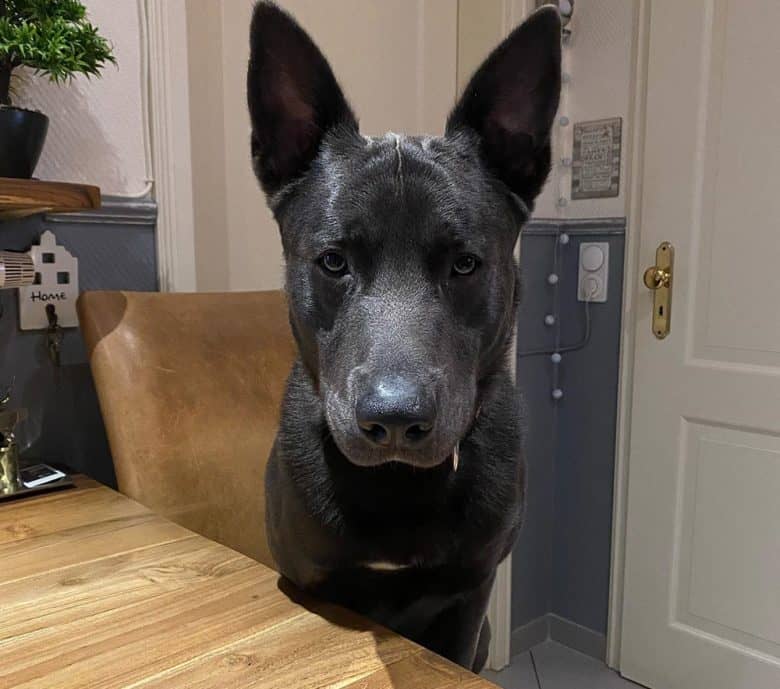
A Blue Belgian Malinois typically has a dilution gene that causes the base coat color to appear gray. This gene will affect your Mal dog’s entire body meaning that the nose, eye rims, and paw pads will also appear lighter in color.
This dilution gene can also affect the eyes, making them appear blue. Gray Belgian Malinois will also not have a black mask.
10. Liver
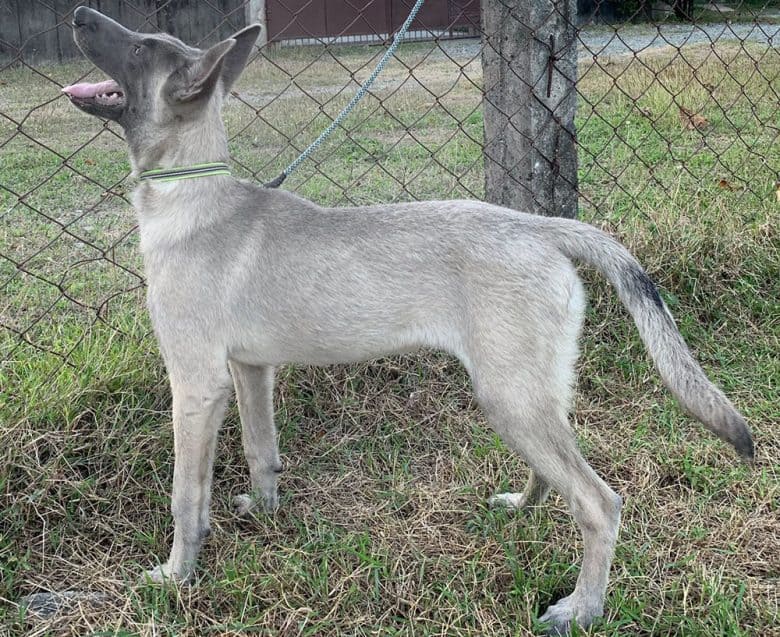
The liver-colored Belgian Malinois is also the product of a dilution gene. This recessive gene needs to be inherited from both parents.
Liver Mal dogs can come in shades of yellow, red, or gray, and typically, there won’t be any black or gray on their coats.
The nose, eye rims, and paw pads will also be a liver color. The eyes of this dog can also be a light-brown or amber color.
11. Gray Sable
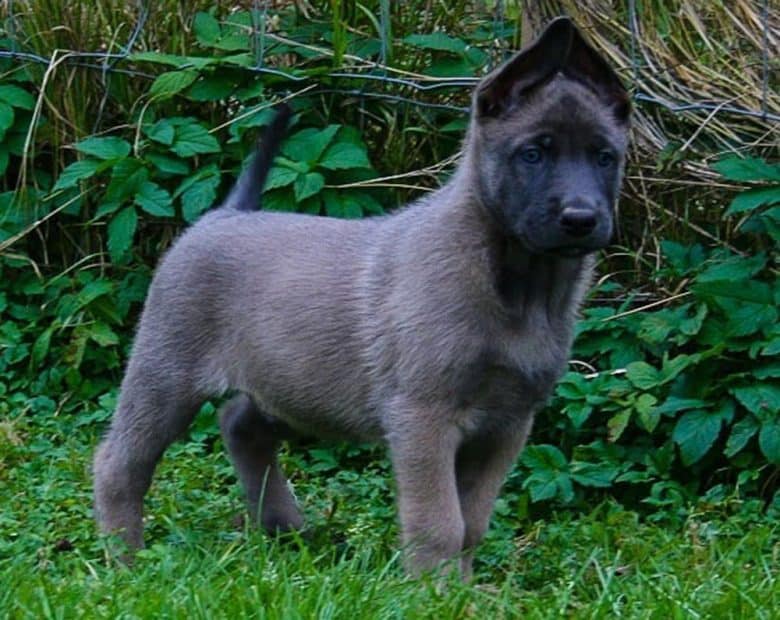
In the Gray Sable Belgian Malinois dog, the dog’s hair resembles an ombre effect, fading from a light gray at the base to a dark black on the tips of the hair.
This is not always obvious, so it can be hard to tell if your Mal dog is a gray sable. The only thing that may give it away is the lighter eye color and lighter eye rims, lips, paw pads, and nose.
12. Cream Sable
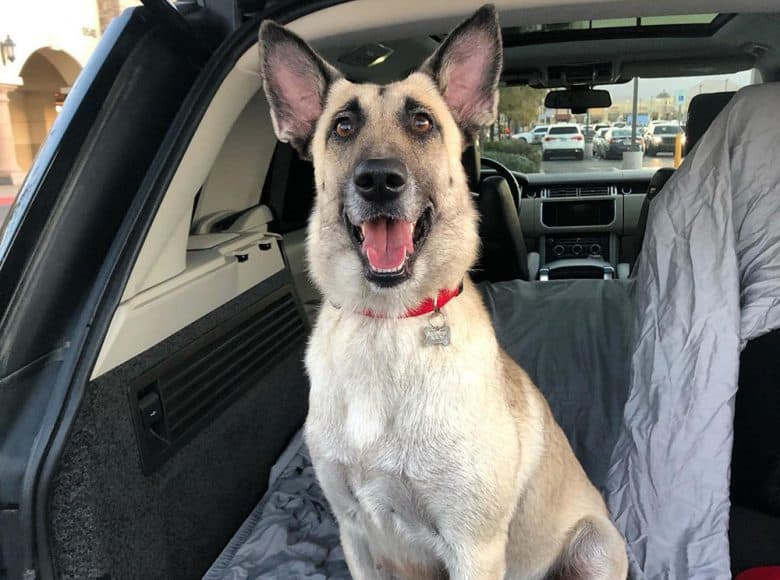
As discussed, sable dogs have a base coat color with black tips on the individual hairs; in this case, the base coat will be cream.
These sable tips will be very noticeable on a cream dog due to the light base color, making it look like your dog is a bit dusty. Most cream-sable Belgian Malinois dogs do not have a prominent black mask.
Belgian Malinois Coat Markings and Patterns (AKC Standard)
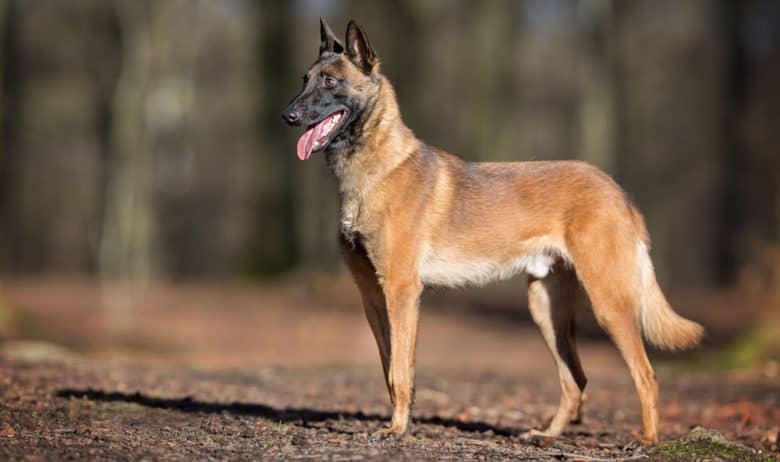
According to the American Kennel Club breed standards for the Belgian Malinois, specific coat markings are allowed and even required for these dogs. The distinctive black mask is this breed’s most prominent and required feature.
- With Black mask and ears: The black mask is the most prominent marking found in the Belgian Malinois breed. In fact, this is the only type of marking that is allowed within the AKC breed standard. All Belgian Malinois coat colors should carry a black mask in some form, except for the liver and gray coat colors. The mask needs to cover the Mal dog’s muzzle at the very least, but it will most of the time extend to the ears, eyes, and nose.
- With Black tips: Most Belgian Malinois dogs will have black ears, paw pads, and a black nose. Additionally, some dogs will have black tips on their individual hairs, giving an overlay appearance. These dogs are said to be sable in color.
- With White markings: The AKC guidelines allow for tiny white markings on any coat color of the Belgian Malinois. These white markings can appear on the very tips of the toes or as a small splash on the chest; however, the marking on the breastbone should not extend up and onto the neck.
What are the Other Colors of Belgian Malinoises?
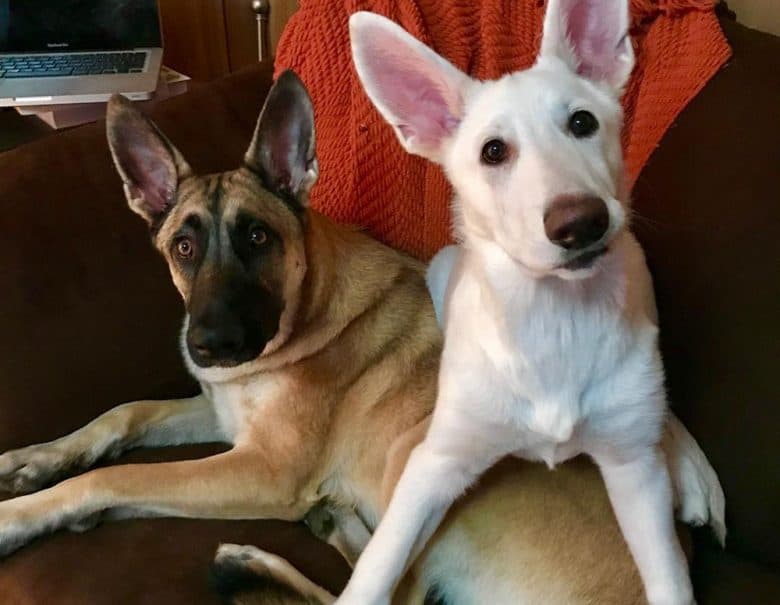
Some other kennel clubs, such as the Canadian Kennel Club, the United Kennel Club, and the Fédération Cynologique Internationale, also accept some other colors for the Belgian Malinois breed.
These colors range from fawn to mahogany and include overlays and mask markings.
1. Black and Tan
Black and Tan is a coat color variant allowed for Belgian Malinois by the Canadian Kennel Club.
These dogs should not be confused with the Black and Tan Coonhound, which is significantly smaller than the Belgian Malinois and belongs to the hound group of dogs rather than the herding group.
2. Gray Fawn
This is another term used by the Canadian Kennel Club when referring to the Belgian Malinois breed, and like the gray color listed by the AKC above, it refers to a dog that carries a dilution gene.
3. Blue Fawn
The Blue Fawn Belgian Malinois listed by the Canadian Kennel Club is quite a rare, and thus valuable, form of coloring.
Once again, these dogs have a dilution gene that makes their coat appear almost blue. This is especially prominent when the dogs are puppies.
4. White
Although the American Kennel Club bans the White Belgian Malinois, the CKC listed pure White Belgian Malinois as acceptable coat color. These dogs are not albinos but carry recessive genes that allow for a white coat color.
5. Fawn and Sable with charcoaling
Similar to the sable fawn color listed by the AKC, the United Kennel Club refers to the Belgian Malinois as having a fawn and sable coat with charcoaling.
Mal dogs with this coat color have a fawn base which gets darker as it extends to the root.
6. Fawn with black overlay
The Fédération Cynologique Internationale is an association of kennel cubs based in Belgium. They only refer to the Belgian Malinois as having a fawn coat with a black overlay.
This means that the dog has a lighter-colored base and then black tips that give it the appearance that one color has been laid over the top of the other.
Mal Dog Colors That Aren’t Allowed
Although the AKC breed standard allows for some deviations found in the five standard Belgian Malinois coat colors, others are outright banned.
Dogs that display these colors cannot be considered purebred Belgian Malinois and are likely crossbreeds. They also typically have a wide range of health problems.
You will not be able to register these dogs, and breeding these colored dogs should not occur.
1. Merle Belgian Malinois
A merle dog is undoubtedly very beautiful, but it’s also fraught with health issues such as blindness, deafness, and bone disease.
This is because the recessive dilution gene that causes the merle coloring affects the pet’s whole body. Merle Mal dogs have patches of different colors on a white base, and often these dogs will have blue eyes.
2. White Belgian Malinois
White is a natural color in many dog breeds, but not with the Belgian Malinois. White in this breed usually indicates a health problem such as albinism.
Albino Mal dogs will have pink noses and light eyes that typically have a pink tinge. Albinism can lead to several health conditions, such as heart disease and blindness.
Mal dogs that inherit two merle genes can also appear white. These white dogs also usually have blue eyes and are often deaf. They are also known to have a shortened lifespan.
3. Bicolor Belgian Malinois
Almost all Belgian Malinois are bicolor due to their black mask, but a tricolor Belgian Malinois is especially rare and not considered a legal coat color for this breed.
These dogs will have a standard base color, black mask, and another color on their body somewhere else.
This could be as simple as a white mark on their chest or stomach, although small white markings are allowed in the breed standard.
What is the Most Common Belgian Malinois Color?
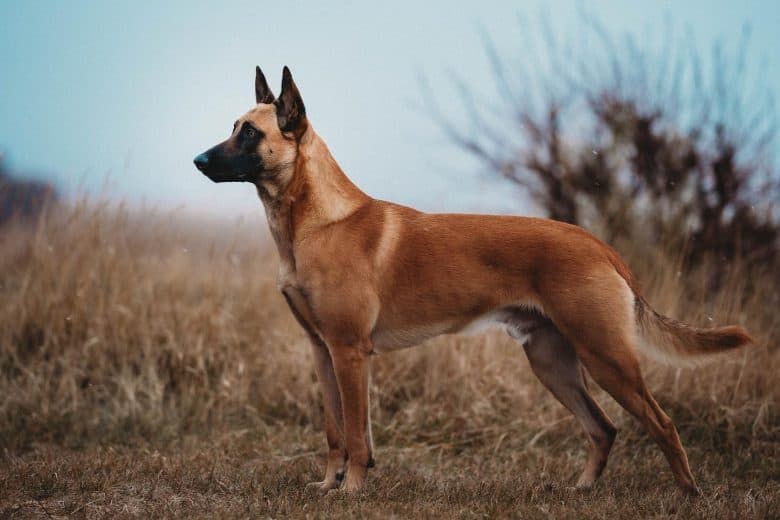
Most of the standard coat colors listed above are common for the Belgian Malinois breed, with fawn being the most frequently found, followed by red and mahogany.
Additionally, all Belgian Malinois, except for some of the coat colors caused by diluted genes, will display a black mask on their face.
What is the Rarest Belgian Malinois Color?
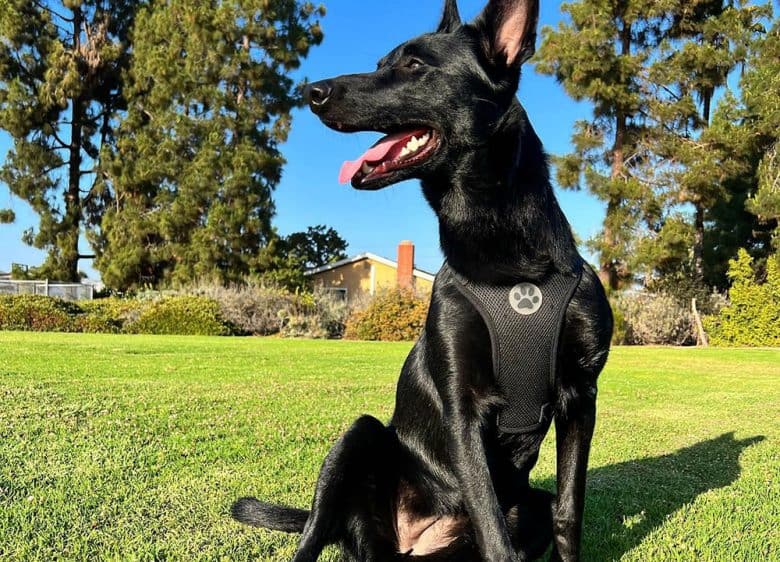
Although not a standard color, the pure Black Belgian Malinois is highly sought after. These dogs have a striking look, making them incredibly popular, but they are still very rare.
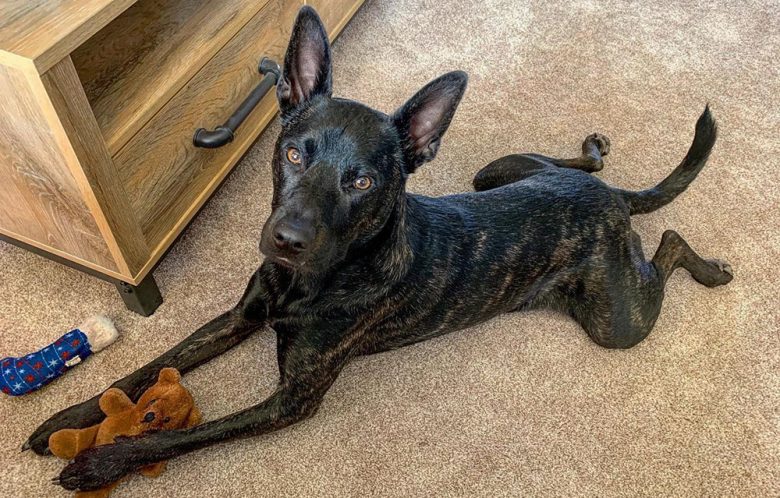
The rarest of all the Belgian Malinois colors, however, is brindle. This is because brindle is caused by a recessive gene that needs to be present in both parents, and this is not typically naturally found in the Belgian Malinois breed.
Mal dogs with brindle coats are likely ancestrally linked through crossbreeding to a Dutch Shepherd or German Shepherd.
Also read: Belgian Malinois vs German Shepherd
Is it okay to get a rare-colored of this breed?
Some breeders will select parent dogs with specific genes to get puppies with a particular coat color. This typically includes breeding two dogs with recessive genes together.
While in some instances, there is no harm to this, too much inbreeding or selective breeding can lead to various health issues for your pup.
Unfortunately, some of the banned coat colors are also quite sought after due to their rarity. However, these dogs can only be bought from unreliable breeders and thus could be riddled with health problems.
Frequently Asked Questions (FAQs)
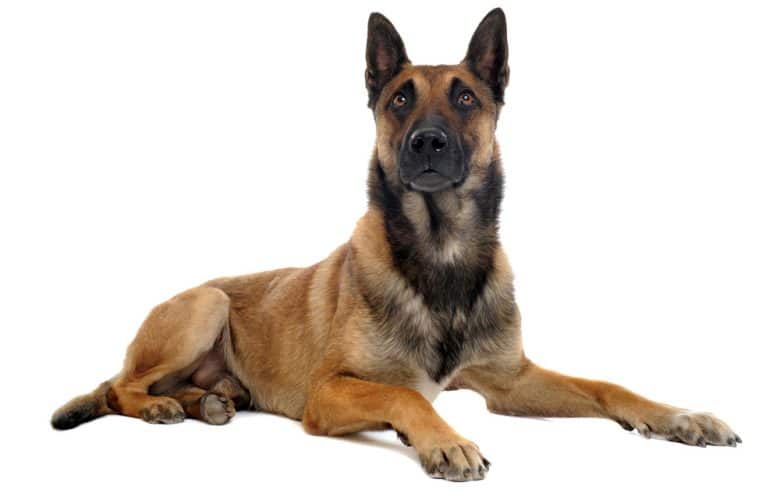
Do Mal colors affect behavior?
Your Malinois dog’s coat color and markings do not affect his personality in any way. However, it may affect how people perceive him, as black or very dark Belgian Malinois can look intimidating and scary.
No matter which color Belgian Malinois you choose, you’re guaranteed an intelligent, loyal dog.
These pooches were initially bred as herding dogs and are no stranger to working hard, meaning they are easy to train and quite ready to lay their lives on the line for those they love the most.
Do Malinois colors affect health?
Yes, your Mal dog’s coat color can affect his health. Some rarer Belgian Malinois coat colors, such as the banned merle or white coats, typically have various health issues.
Conditions such as blindness, deafness, and heart disease are frequently linked to dogs displaying these coat colors.
Dogs with dilution genes, such as gray or liver-colored Belgian Malinois, are also typically more prone to health problems.
Do Malinois dogs change eye color?
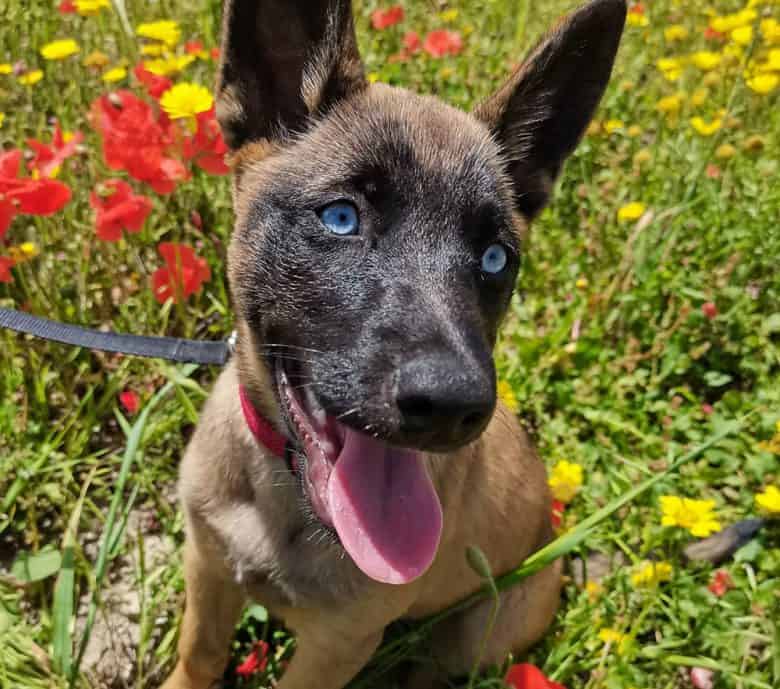
All Belgian Malinois have almond-shaped eyes that are dark brown or almost black and will be that way from just a few days old.
The only exception to this rule is the dogs with diluted genes, such as Liver or Gray Belgian Malinois, which can have blue or amber eyes.
What’s the color of the nose of a Malinois?
According to the AKC and most other major kennel clubs, the nose of the Belgian Malinois should be dark brown or black.
This may only differ with liver or gray dogs that may experience dilution, giving their nose a lighter appearance or a patchy look.
Taking Care of Your Mal Dog’s Coat
Unlike the German Shepherd, who has quite a fluffy coat, the coat of the Belgian Malinois is relatively short.
However, it is a double coat, which means that it has a dense undercoat that sheds quite heavily, particularly with the changing seasons. This isn’t a dog for allergy-prone owners.
While Malinois dog’s coat isn’t difficult to maintain, regular brushing will help to remove any loose hairs and keep the hairs around your house to a minimum.
To keep their coat looking its best, you should also ensure that you feed your pet high-quality dog food.
Regular nail trimming and teeth cleaning are also essential. You may also need to get your Mal dog’s ears plucked on occasion.
Which Belgian Malinois Color Will You Choose?
So which Belgian Malinois is the best for you? In the end, unless you plan to show your dog in a conformation ring, it doesn’t matter, as long as your pet is happy and healthy.
That’s why it’s best to avoid rare colored Belgian Malinois, which are often bred by unethical breeders and can come with many health problems.
If you can provide your Belgian Malinois with strong guidance and good socialization training, you will be rewarded with a loving, loyal dog that makes a great family pet.
That said, this is one hardworking, intelligent breed that is not for novice pet owners.
Do you have a Belgian Malinois at home, or does one of these fine canine companions work for you? Let us know all about your furry friend in the comments below.
Further Reading:
Are you considering getting a Belgian Malinois, but you’re not quite ready to take the plunge? Do you need to do some more research into the breed before you decide to buy?
Here are some resources you can consult that will help you in your search for the perfect pooch.
Cess is the Head of Content Writing at K9 Web and a passionate dog care expert with over 5 years of experience in the Pet Industry. With a background in animal science, dog training, and behavior consulting, her hands-on experience and extensive knowledge make her a trusted source for dog owners.
When not writing or leading the K9 Web content team, Cess can be found volunteering at local shelters and participating in dog-related events.
